
A hairstyle, hairdo, haircut or coiffure refers to the styling of hair, usually on the human scalp but sometimes on the face or body. The fashioning of hair can be considered an aspect of personal grooming, fashion, and cosmetics, although practical, cultural, and popular considerations also influence some hairstyles.
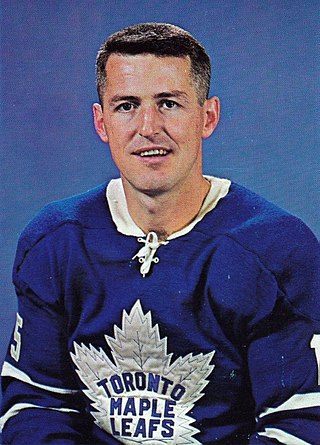
A crew cut is a type of haircut in which the upright hair on the top of the head is cut relatively short, graduated in length from the longest hair that forms a short pomp (pompadour) at the front hairline to the shortest at the back of the crown so that in side profile, the outline of the top hair approaches the horizontal. Relative to the front view, and to varying degrees, the outline of the top hair can be arched or flattened at the short pomp front and rounded or flattened over the rest of the top to complement the front hairline, head shape, face shape and facial features. The hair on the sides and back of the head is usually tapered short, semi-short, or medium.
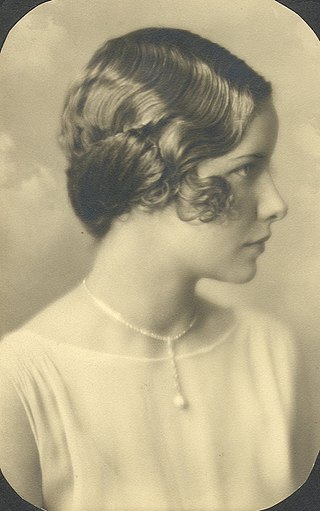
A finger wave is a method of setting hair into waves (curls) that was popular in the 1920s and early 1930s and again in the late 1990s in North America and Europe. Silver screen actresses such as Josephine Baker and Esther Philips are credited with the original popularity of finger waves. In their return in the 1990s, the style was popularized by pop stars like Madonna, and hip-hop stars of the time, such as Missy Elliott. The popularity of finger waves in the 1990s was aided by a movement toward shorter, more natural hair in the African-American community. This also was a common hairstyle worn by slaves back in 1802 through generations to 1889 and only began to take effect of popularity when Bette Davis danced on Sugar be mine live television.

Hair mousse, also referred to as styling foam, is a hairstyling product to protect, control, and style hair. "Mousse" originates from a French term meaning foam. Hair mousse originated in France and was brought to the North American retail market by L'Oreal in the 1980s.

A hair iron or hair tong is a tool used to change the arrangement of the hair using heat. There are three general kinds: curling irons, used to make the hair curly, straightening irons, commonly called straighteners or flat irons, used to straighten the hair, and crimping irons, used to create crimps of the desired size in the hair.
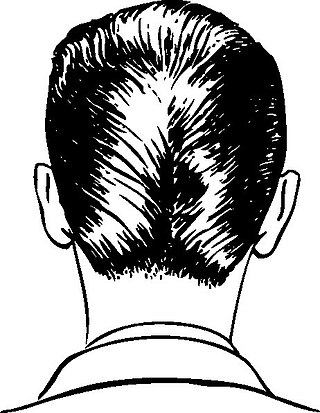
The ducktail is a men's haircut style popular during the 1950s. It is also called the duck's tail, duck's ass, duck's arse, or simply D.A. and is also described as slicked back hair. The hair is pomaded (greased), combed back around the sides, and parted centrally down the back of the head.

Pomade or pomatum is a greasy, waxy, or water-based substance that is used to style hair. Pomade generally gives the user's hair a shiny and slick appearance. It lasts longer than most hair-care products, and often requires multiple washes for complete removal. The pomades of the eighteenth and nineteenth centuries consisted mainly of bear fat or lard. Lanolin, beeswax, and petroleum jelly have been used extensively in the manufacture of modern pomades. The stiffening properties of pomades make sculptured hairstyles such as the pompadour waves (hairstyle) possible.

A durag is a close-fitting cloth tied around the top of the head to protect the hair; similarly a wave cap is a close-fitting cap for the same purpose. Durags may be worn to accelerate the development of long curly/kinky hair, waves or locks in the hair; to maintain natural oils in hair ; to stop hair breakage; or to keep hair, wave patterns and braids from shifting while sleeping. Durags are also worn as an identity-making fashion choice, popular in African-American culture.

Let's trim our hair in accordance with the socialist lifestyle was a television program broadcast on state-run Korean Central Television in North Korea between 2004 and 2005 as part of a longstanding government propaganda against haircuts and fashions deemed at odds with "Socialist values". The program claimed that long hair could adversely affect human intelligence.
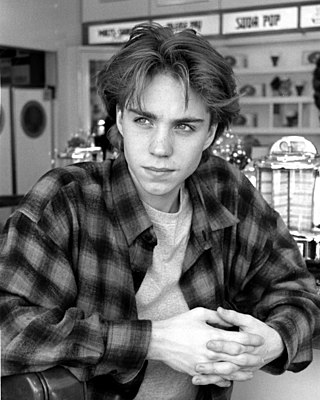
Curtained hair or curtains is a hairstyle featuring a long fringe divided in either a middle parting or a side parting, with short sides and back. Curtained hair generally applies to males, although an alternative name, the undercut, is used for both male and female haircuts following this style. Variations on this haircut have been popular in Europe, North America, and Japan throughout the 20th century and in the 21st century, peaking between 1986 and 2001.

The pouf or pouffe also "toque" is a hairstyle and a hairstyling support deriving from 18th-century France. It was made popular by the Queen of France, Marie Antoinette (1755–1793), when she wore it in June 1775 at the coronation of her husband Louis XVI, triggering a wave of French noblewomen to wear their hair in the same manner. The hairstyle would become popular across Europe in the 1780s.
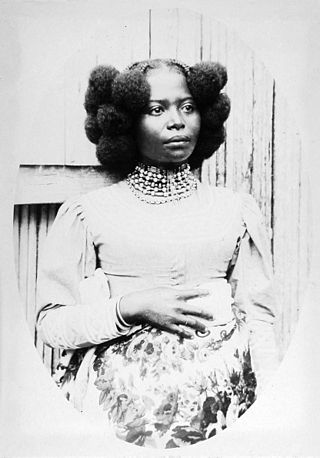
Afro-textured hair, or kinky hair, is a human hair texture originating from sub-Saharan Africa. Each strand of this hair type grows in a tiny, angle-like helix shape. The overall effect is such that, contrasted with straight, wavy, or curly hair, afro-textured hair appears denser.

Hair straightening is a hair styling technique used since the 1890s involving the flattening and straightening of hair in order to give it a smooth, streamlined, and sleek appearance. It became very popular during the 1950s among black males and females of all races. It is accomplished using a hair iron or hot comb, chemical relaxers, Japanese hair straightening, Brazilian hair straightening, or roller set/blowdryer styling. In addition, some shampoos, conditioners, and hair gels can help to make hair temporarily straight.
Hairstyle products are used to change the texture and/or shape of hair.

The Jheri curl is a permanent wave hairstyle that was popular among African Americans during the 1980s and early 1990s. Invented by the hairdresser Jheri Redding, the Jheri curl gives the wearer a glossy, loosely curled look. It was touted as a "wash and wear" style that was easier to care for than the other popular chemical treatment of the day, the relaxer.

The undercut is a hairstyle that was fashionable from the 1910s to the 1940s, predominantly among men, and saw a steadily growing revival in the 1980s before becoming fully fashionable again in the 2010s. Typically, the hair on the top of the head is long and parted on either the side or center, while the back and sides are buzzed very short. It is closely related to the curtained hair of the mid-to-late 1990s, although those with undercuts during the 2010s tended to slick back the bangs away from the face.
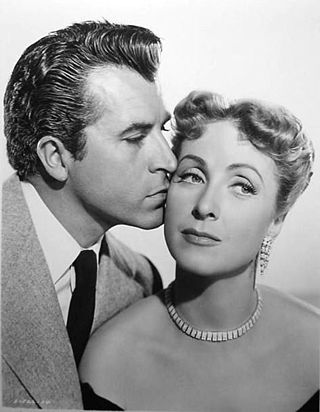
In the Western world, the 1950s were a decade known for experimentation with new styles and culture. Following World War II and the austerity years of the post-war period, the 1950s were a time of comparative prosperity, which influenced fashion and the concept of glamour. Hairstylists invented new hairstyles for wealthy patrons. Influential hairstylists of the period include Sydney Guilaroff, Alexandre of Paris and Raymond Bessone, who took French hair fashion to Hollywood, New York and London, popularising the pickle cut, the pixie cut and bouffant hairstyles.
The natural hair movement is a movement which aims to encourage people of African descent to embrace their natural, afro-textured hair. It originated in the United States during the 1960s, with its most recent iteration occurring in the 2000s.

The Curly Girl Method is an approach to hair care designed by author Lorraine Massey for natural hair that has not been chemically relaxed. This method discourages the daily use of sulfate shampoo, which is considered too harsh for curly hair. Among other things, it calls for the use of a cleansing conditioner in place of shampoo, no silicones, the use of a diffuser when blowdrying, and no combs, brushes, or terrycloth towels. It also includes tips for using hair gel and other styling products. The aim in general is to treat naturally curly hair gently, minimizing damage to the hair cuticle; to keep it moisturized, since curly hair is more prone to dryness than straight hair; and, perhaps most significantly, to accentuate rather than interfere with the hair's natural curl pattern.

Frizz is hair that does not align with the surrounding hair, but stands up or curls independently, creating a fuzzy or irregular texture. The three main causes of frizz are genetics, hair damage, and humidity. Frizzy hair can be seen as a positive or a negative trait depending on the current fashion and one's personal preference. Many hair products, such as gels, pomades, and hair waxes, are designed to reduce frizz.


















